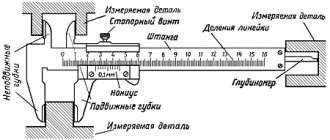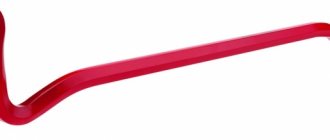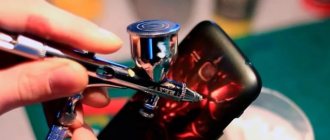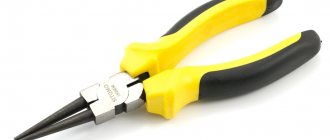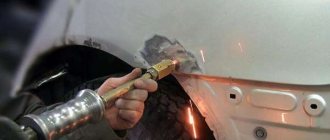One of the simplest measuring and high-precision tools, which is distinguished by its versatility and ability to measure internal and external diameters, is a caliper.
Among its many types, having different sizes, you can find options with the smallest error.
The tool itself is actively used in everyday life, and in turning it is completely impossible to do without it.
Vernier caliper design
Understanding the design features of this device is necessary in order to understand how to use it correctly. The caliper consists of the following parts.
- Fixed bar or ruler (bar). It represents the basis of the structure. There is a scale on it.
- A movable bar that can move along the bar. This bar has a vernier scale. It allows you to get very accurate measurements, namely, it counts fractions of a millimeter.
- Upper and lower lips. These are moving parts that allow you to measure an object and find out the dimensions both outside and inside. When the jaws are perfectly aligned, the zero marks on both scales should exactly match.
- Locking or clamping screw. It is required to fix the bar.
- Depth gauge. A thin retractable bar used to measure depth. Electronic measuring devices are also equipped with batteries and a mobile mechanism.
Vernier caliper design
In addition, there are models in the upper part of which there is a movable inch measuring scale. They are easy and convenient to use.
What types of calipers are there, their design and photos
First of all, it must be said that since Soviet times there has been a classification of calipers, numbering 10 main names, not counting special tools, which we will recall below. Of course, there is no point in listing them all (anyone who wants to can find this information on the Internet). We will consider only the main versions of this instrument.
This photo and the photo of a modern rod posted above show ShTs-I, a tool with double-sided jaws, one for measuring external dimensions (5), the second for internal ones (4), having an additional depth gauge rod (6) located in the groove main rod.
A movable frame (2) with a vernier scale (7) moves along the rod (1) with the main measurement scale (3). The frame is fixed with a clamping screw (8).
Of the entire range of calipers, we will also be interested in the marking calipers ShTsR and ShTsT-I, which have carbide tipped ends of the jaws - for marking parts made of hard metals.
The changes concern more details of the design of calipers. They may differ slightly from each other in design (single-sided and double-sided jaws, the presence or absence of a micrometric feed frame (8), made from different materials, etc.)
And yet, for the average user, the fundamental differences will be between instruments with the designations ШЦК - with a circular measuring scale and ШЦЦ - with a digital electronic scale.
Types of calipers
There are three main types of such devices. Their use for a certain type of work is determined by its characteristics.
- Vernier or analog calipers. Measurements are made on a vernier scale. These power tools are simple and inexpensive. They are the most common.
- Dial or pointer calipers. To measure, instead of a scale, they have a dial that shows the results and does not require calculations. Their cost is higher than analog models. They are easy to use.
- Digital or electronic calipers. These are devices that have liquid crystal digital displays with rechargeable batteries. The use of such devices allows you to obtain the most accurate results. They show data in both millimeters and inches.
Electronic caliper
In addition to those listed, there are also models of special-purpose calipers. They are used for special jobs. For example, ШЦЦП, which measures parts with protrusions, or ШЦЦП - a design for measuring the tread pattern of tires, etc. These devices are not sold in regular stores; if necessary, they can be purchased on special websites. They are used by professional craftsmen.
All types of calipers have their own designations depending on the specific application.
- Vernier caliperSHTs-1. They measure parts, their external and internal dimensions using two pairs of sponges. It can also be used when measuring the size of a hole using a depth gauge.
- ShTs-1S. Such devices are equipped with arrow heads, making the measurement process simplified.
- Shtsk. Designs with a dial scale with a spring mechanism. It can be used for measurements when perfect accuracy is not required.
- SCT-I. Devices equipped with carbide-coated jaws to prevent surface abrasion. They are resistant to wear and can be used for a long time.
- SHTs-II. In addition to the jaws, such devices also have a mechanism for feeding the frame. Thanks to this, markings can be applied.
- SHTs-III. This device is large in size. The jaws on it are one-sided. Not suitable for depth measurement.
- SCC. A device with a digital scale from which readings are taken.
Vernier caliper ShTsK
Each type of caliper is manufactured in accordance with the currently valid GOST 166-89 and is marked accordingly.
Measurement order
Now let's talk about how a caliper works. Before you start using it, you need to prepare the device and the part being measured: clean the surface of dirt to ensure maximum accuracy. The jaws need to be brought together tightly and the size of the gap between them needs to be assessed. If the design is working properly, then it will be minimal.
Next, the movable frame must be moved so that its first mark coincides exactly with the zero mark on the rod scale. If this is not taken into account and implemented, the results will not be accurate. If you cannot match these marks, then the caliper is faulty and is not recommended to be used. Only after making sure that the structure is completely prepared can you begin to work.
Measuring external surfaces
When it is necessary to measure a linear dimension or outer diameter, the sequence of using the tool is as follows. First of all, the sponges need to be spread apart by moving the frame. And then press them tightly against the opposite surfaces of the part that needs to be measured, and secure the position of the frame with a screw. If the outer diameter of a cylindrical part is measured, then its axis must be exactly perpendicular to the plane of the frame. If the length of a part or product is measured, then its longitudinal axis should be located exactly parallel to the rod. These conditions must be observed when using a caliper, otherwise it is impossible to obtain accurate results.
Measuring external surfaces with calipers
Measuring internal surfaces
If you need to measure the diameter of the hole, the outer jaws must be set to zero. They must be inserted into the hole that needs to be measured. It is necessary to hold the caliper straight. Next, the jaws need to be spread all the way, so that they are pressed tightly against the inner walls of the part. Secure their position using the locking screw. Then readings are taken and the necessary calculations are made if a vernier caliper was used.
Measuring internal surfaces with calipers
Depth detection
To measure the depth of the hole, you will need to move the frame and extend the depth gauge. Then insert it all the way into the hole so that the end touches the bottom. It must be positioned exactly perpendicular to the surface of the part being measured. Press against the wall. Move the bar to the end also until it stops. Using the locking screw, secure the position and remove the device.
Measuring depth with a caliper
Measuring threaded connections
A caliper can be used to measure threaded connecting parts - screws, bolts, etc. Thread diameters are determined by the protrusions. For this purpose, the screw or bolt to be measured should be installed vertically and clamped with jaws. After this, it is possible to determine the necessary indicators.
If you need to measure the thread pitch using a caliper, this is done in the following sequence. First, the height of the rod and the outer diameter of the part are measured. And then the number of thread turns is counted. By dividing the length of the rod by the number of turns, you can get the thread pitch indicator.
Measuring threaded connections with a caliper
Reading on a vernier caliper
The readings on such a device are determined by adding the values of the main scale and the vernier scale. The order is as follows:
- On the main scale, whole millimeters are counted, which are located to the left of the vernier zero.
- The vernier mark, which coincides with one of the marks on the rod, determines fractions of a millimeter. Next, you need to multiply the division price by the serial number of the vernier marks determined by us.
How is the count made when measuring with a caliper?
In the example given, whole millimeters located to the left of the vernier zero are highlighted in bold and amount to 4 mm. And the required vernier mark is marked in red, the mark is 5. We multiply the price of the vernier division (in the example 0.1 mm) by the number of the vernier mark 0.1 x 5 = 0.5 mm, this is how the shares are determined. The readings are as follows: 4 mm + 0.5 mm = 4.5 mm.
Measuring the diameter of a washer with different calipers
The second figure shows an example of measuring the diameter of a washer using a caliper with a vernier scale of 0.05 mm. According to the counting method, the measured value is 50.2 mm, which is confirmed by the readings of a digital device. It should be noted that 4 marks coincide on the vernier; when multiplied by 0.05, we get the value of 0.2 mm (this mark has the number 2).
For a better understanding of the readings, see the following live picture.
Measuring the external size of the nut
Reading results
It is not difficult to read the results obtained using a caliper. On the fixed frame (bar), where the main scale is located, determine the integer number (mm). The vernier scale shows hundredths of a millimeter. You need to find the line of the vernier scale on the caliper you are using that matches a certain number on the main scale. This indicator will be the value of the part size in millimeters.
Vernier scale
It happens that when measuring, a whole indicator is sufficient. If you want to set the value more accurately, you need to inspect the vernier scale. And on it you need to find the point of coincidence of the two marks. The number on the vernier scale will indicate the tenth value. By adding it to an integer, the user will receive the exact size of the part.
Reading the result by vernier
By hourly indicator
When using a dial caliper, the whole number in millimeters can also be seen on the main scale. As on an analog device, it is determined by the coincidence of marks on both scales. The number presented on the dial shows a value from 0.01 to 0.99 mm, this depends on the value of the scale division. A pointer or dial caliper is a more accurate device than a mechanical (analog) one. It should be used when it is necessary to obtain perfectly accurate data.
Reading results on a pointer caliper
By digital display
High-precision (up to hundredths of millimeters) readings of the results obtained when working with a digital caliper are presented on the liquid crystal display of the scoreboard. It is necessary to remember that it has different modes that show measurement results in both millimeters and inches. Such devices are also equipped with a vernier scale. It can be used if, for example, the battery runs out.
Types of special calipers - photo
Very often, based on this tool, special measuring instruments with a narrow range of action are produced (for measuring the diameters of internal and external grooves), both factory-made and workshop-made, and sometimes for performing one single operation, but very repeatedly (for measuring the distance of a hole of a given diameter from the edge of the part) etc.
There are devices that take several measurements simultaneously.
And very special, like a caliper for measuring the geometric parameters of welds of joints of different thicknesses.
There are such tools in nature as depth gauges.
But more accurate measurements are carried out with instruments called a micrometer (up to 1/1000), but it is unlikely to be useful at home.
It should also be remembered that for instruments that are used in production, where high precision of the device is required, it is recommended to have it calibrated in special institutions.
We recommend other articles on the topic
Hand drill for excavation work - do it yourself
Gun for polyurethane foam - the right choice, disassembly and repair
Choose a paint sprayer or make your own sprayer
Rotary hammer, hand drill - in what cases should it be used?
How to properly store a tool
To extend the life of your caliper, it must be stored properly. To do this, you should use a special case. It is recommended to periodically wipe the surface of the device with a soft cloth to remove dirt. If used frequently, it does not require additional protective measures. If you use it rarely, then you need to treat it with machine oil. It is necessary to avoid exposure to moisture and sunlight and mechanical damage - impacts, scratches, etc.
Storing the caliper
A caliper is a tool that is often required by both professional craftsmen and amateurs. If you need to take measurements frequently, you will need to purchase such a device. When choosing the right model, the user should be guided by the specifics of the work, taking into account the design features and cost of such tools.
